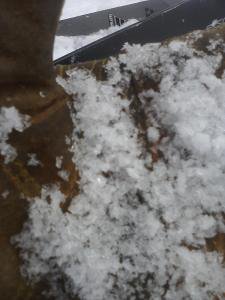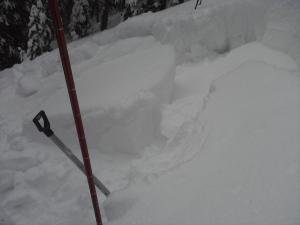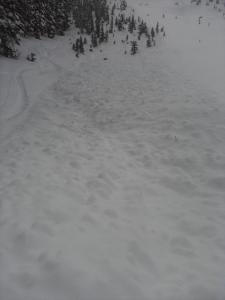Headed up the Visti sipping a forty and listening to Def Leppard. Around Visti pole six I shot up, and by the top I was feeling loose. By the time I reached the Top of the World, I was cross-eyed and tingling. Continued down to Old Man’s where I stripped off all my clothes and straight lined the middle of Old Man’, still listening to Def Leppard and screaming “Ski to Die” with a Born to Lose tattoo on my bare chest, just like I did last week. Passed out in the trees at the bottom. Woke up an hour later, and started my traverse out.
It must have come to me in a dream, that everywhere in EV was filled with evidence of the large cycle that happened this Sunday. Crowns and debris were everywhere in areas over thirty degrees, N-NE facing in the trees. Found a good spot on a NE convex roll over around 9500 feet in a 150 foot wide clearing that had fractured during the avi cycle. A good spot to test in as the hangfire was minimal above, about fifteen feet to the line of trees and bed surface under my feet.
I wanted to check out the snowpack, and then do a couple tests and see if my results were in line with the obvious instability. Also I wanted to see if stability was any better a couple days after the event. I found the spot. It was N-NE facing, the roll over pitching to 36 degrees at the top of the crown. I choose to do a full pit profile, then compression tests and lastly an AK block, a test created in Alaska by Bill Glude.

Imagine a heli just dropped you and your clients off and you have to assess and go. Time is money in this biz so you need to be thorough but quick. Fifteen minutes is your time. You need a graduated probe, two dial snow thermometers(digital suck) a snow saw a field book and a pencil. Keeping your pack and gloves on, lay your pole on the snow and use your shovel to make a nice clean wall down 160 cms the length of the pole in AK here to the ground. Why 160? Hard to trigger a weak layer over six feet, a full column would take too long in AK in the field. Put your probe in the side of the pit to use as a measuring stick.

Dig your pit and smooth the face of the area as wide as your pole. Enough room to not only look at the snow but then be able to cut columns for your test. Profile the snow on the graph in your book, noting hardness, depth of different layers, different crystal types and sizes. Also note temperature gradients every 10 cms(temperature gradients indicate poor adherence from one layer in the snow pack to the other. By using two thermometers at once you can expedite the process. You also note time, aspect, elevation, sky cover, snow and snow surface temp Looking for obvious weak layers, crusts and density changes. Use your hand brush whatever to feel the layers out and expose them. Mark three shovel indentations gently on top of the snow and isolate each shovel mark and the sides of the block with your saw.

Cut the back of the block from both sides with your saw and eliminate the column in the middle. Now you have two isolated columns. Do your CT(compression tests wrist, elbow and shoulder.) tests and check your results.
I dug to 110 cms and hit ground. I got Ct-2(compression test with failure on two wrist taps)on both columns with a Q1(very clean, easy) and Q2 sheer(moderately easy, not as clean) respectively at 60 cms on the old settled storm snow(.5 mm degraded stellars) interface on the 2mm loose facet layer. That means very not good. If you were guiding, you’d get the hell out of there.

Looking down the fracture line, I saw this was the layer weak layer on which the slab ran, probably triggered by a traversing skier or maybe naturally during Sundays’ cycle. So far so good. My transient test results confirmed the still awful stability in the trees.
Next was an AK block, a Reuchblock without the back cut, basically to make it more representative of a natural slope. Lay your skis out and dig the block face to your desired depth, 160 cms again is good. Isolate the sides of the block to a pole length with your shovel/saw.
The idea is to get your skis on, and get on the block. First flex your knees, then a deep flex then a series of jumps until you get the block to fail. Then you determine the stability by that number.
Cut my block, took my skis than took one boot step uphill next to the block and the convex roll fractured 4 feet above the last crown 75 feet wide and moved about a foot. Exactly why you keep your Float pack on during a test. It did surprise me and I ended up hugging a chair sized block but again the slide had happened here couple days ago and I was standing on bed surface. I can only imagine what is was like on Sunday in these trees. The block itself triggered remotely with a Q1(easy clean) shear as well.

If you were doing any of these tests on a uncontrolled slope, you would have a spotters and/or anchors. Make you own decisions and do your own tests on your own ability level, using your own judgement. I skied down linking snow-covered debris piles to stay out of trouble.

Snowpack: No significant temperature gradients in the pack
Here’s what i saw in my pit.
Ground to Twenty cms: Four finger 3mm moist loose facets.
Twenty to Sixty cms: Fist 2mm loose facets
Sixty to One hundred cms: four finger settled old storm snow .5 mm degraded stellars
One hundred cms to one ten cms: Fist light new snow 2-3 mm stellars
At Sixty cms: the interface between the denser old storm snow and the loose facets was the spot where things have been triggering down lower in the trees.









Comments